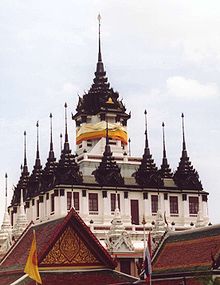Wat Ratchanatdaram
Wat Ratchanatdaram ( Thai : วัด ราช นัดดา ราม ) is a Buddhist temple complex ( Wat ) in the Phra Nakhon district of Bangkok , the capital of Thailand . It is a 3rd class royal temple . Its full name is Wat Ratchanatdaram Worawihan (Thai: วัด ราช นัดดา ราม วรวิหาร ), but mostly it is called Wat Ratchanatda for short . In 2005, Wat Ratchanatdaram was proposed for the UNESCO World Heritage List for Asia .
location
Wat Ratchanatda is located at the intersection of Ratchadamnoen-Klang Boulevard and Thanon Mahachak (Machachak Street) on the northeastern edge of the " Rattanakosin Island ", parallel to the Ong Ang Canal (Khlong Ong Ang) . Opposite on the other side of the canal is Wat Saket with the Phu Khao Thong ("Golden Mountain"). From Wat Thepthidaram , which is directly to the south, it is only separated by a narrow channel ( khlong ) . This channel, called Khlong Wat Thepthidaram , represents a connection between Khlong Ong Ang and Khlong Lord.
history
King Nangklao (Rama III) had Wat Ratchanatda built in 1846 for his niece Mom Chao Ying Sommanad Wattanawadi (Thai: หม่อมเจ้า หญิง โสมนัส วัฒนา วดี , mostly: Sommanus Wattanavadi ) in order to offer her an undisturbed meditation environment. Therefore, the king chose the name "Wat Ratchanatda" (roughly: monastery of the royal niece ) for the temple . Mom Chao Ying Sommanad Wattanawadi later became the queen of King Mongkut (Rama IV) .
Until 1989 the temple was hidden behind a large cinema building called "Chalerm Thai". In the course of the beautification of Ratchadamnoen Boulevard, it was torn down and replaced by a park-like square with a traditional Thai-style pavilion ( sala ) and a statue of King Nangklao. The pavilion and square are called Maha Chesdabodin Pavilion and Plaza .
buildings
Ubosot
The central sanctuary, the ordination hall ( ubosot ) , is flanked on the right and left by a viharn , the axis of which runs perpendicular to the axis of the ubosot. It is in the style of the time of King Nangklao (Rama III) . Rectangular pillars support the three-tiered roof. The gable field decorated with gilded stucco is remarkable. The main Buddha statue was cast from a copper alloy in 1864, and King Mongkut (Rama IV) later named it Phra Setthamuni . The interior walls are decorated with beautiful old wall paintings.
Loha Prasat
The temple is known for the Loha Prasat (Thai: โลหะ ปราสาท - iron palace ). This chedi , built in an unusual style for Thailand, is a replica of a similar building built by King Dutthagamani of Anuradhapura around 150 BC. Was built. This building was called "Lovamahapaya" or "Lohaprasadaya" and was unique in its time: it was a nine-story building with a side length of 120 m, a total of 1600 stone pillars formed the foundation, which is still preserved today. It is said to have been covered with bricks made of bronze, hence the name Bronze Palace ( Brazen Palace ).
King Nangklao had studied Sri Lankan Buddhism when he came up with the idea for this building. Construction of the Loha Prasat in Bangkok began during his reign, but was not finally completed until the reign of King Vajiravudh (Rama VI) .
The outside of the Loha Prasat is reminiscent of a three-tier pyramid. It is 36 m high and has 37 metal chedis with a Burmese umbrella ( Hti ) on their top . The top floor is designed as a mondop . Inside the Mondop there is a shrine with a dark vessel that is said to contain a relic of the Buddha. In the middle of the building there is a staircase with a spiral staircase that can be used to reach the top floor. There are numerous meditation cells on the lower floors.
Kutis
The monk cells ( kutis ) of the "Sanghawat" living area of the monks are similar to Wat Thepthidaram in the style that was typical for the time of King Nangklaos.
Individual evidence
- ↑ Article about Mom Chao Ying Sommanus Wattanavadi in the daily newspaper The Nation ( Memento from June 26, 2007 in the Internet Archive ) (in English)
- ↑ Antique photography (around 1900) of Loha Prasat. From the collection of the Cornell University Library.
Coordinates: 13 ° 45 ′ 17 ″ N , 100 ° 30 ′ 17 ″ E


